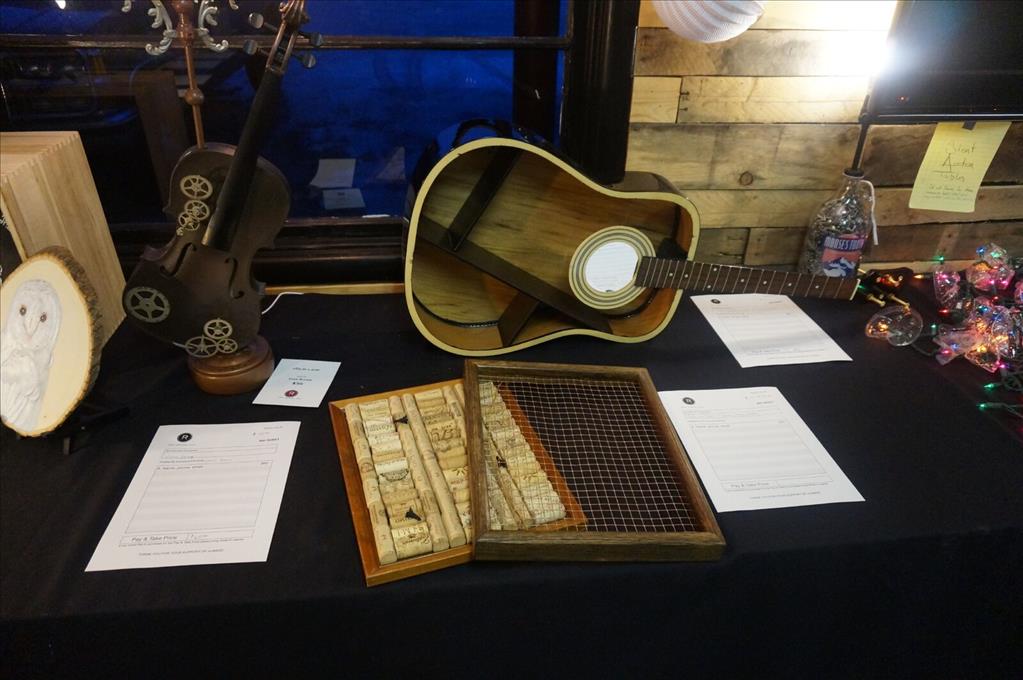Motivating kids to move
by Tracy Kalytiak |
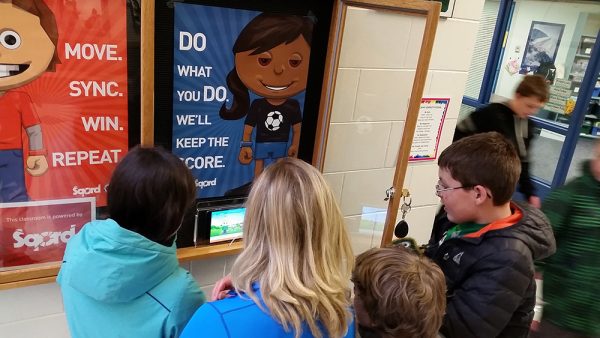
Huffman Elementary School third-graders Caleb Asselin and Ashlyn Richards and sixth-grader John Richter sync their Sqord "activity pods" with the Sqord fitness platform. UAA ISER researcher Mouhcine Guettabi is collaborating with Providence, Anchorage School District, Healthy Futures and the State of Alaska to learn more about effective ways to motivate kids to be active. (Photo courtesy Melanie Sutton, Anchorage School District)
Do colorful watch-like "activity pods" tethered to a social and competitive online platform make a difference in how often and how intensely kids run, play, or otherwise get physically fit?
That's what UAA ISER researcher Mouhcine Guettabi hopes to find out through a research collaboration he's been conducting since Fall 2014 with the Anchorage School District, Providence Alaska Medical Center, the Healthy Futures nonprofit, and the State of Alaska.
"There's a burgeoning interest among researchers and physical activity professionals in health-care interventions that incorporate technology," said Guettabi, an assistant professor of economics, about the use of Sqords, Fitbits and other accelerometer-based devices, mobile apps and web-based coaching.
Tackling a weighty problem
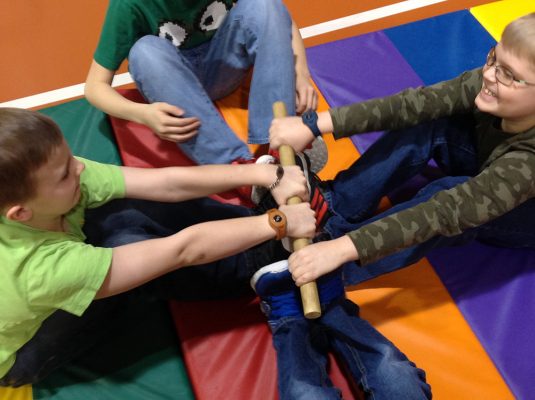
Rogers Park Elementary School students do a stick-pull exercise while wearing watch-like Sqord "activity pods" that score their movements. UAA ISER researcher Mouhcine Guettabi is collaborating with Providence, Anchorage School District, Healthy Futures and the State of Alaska in studying the best ways to motivate kids to be active. (Photo courtesy Melanie Sutton, Anchorage School District)
Learning how to motivate kids to move is critical because too many children lead sedentary lives. Hours spent in front of a computer or TV, with little to no time spent playing, increase the likelihood a child will grow unhealthy habits leading to preventable and costly health calamities like obesity, diabetes, high blood pressure and heart disease.
The National Survey of Children's Health found that only 34.2 percent of children aged 6-17 nationally and 28.8 percent of children in Alaska engaged in physical activity for 20 minutes or longer on three or fewer days. And, nearly a third of children aged 10-17 are overweight or obese-31.2 percent nationally and 29.9 percent in Alaska.
Providence Health & Services decided to grapple with the issue, making Sqord Active Play Program accelerometer devices available to ASD and students in Kodiak and the Kenai Peninsula on a voluntary basis.
Providence has invested $853,655 in the project, to date, partnering with Healthy Futures and the Alaska Division of Public Health's Obesity Prevention and Control program, in addition to the school districts. Premera Blue Cross Blue Shield contributed $20,000 to the effort.
Sqords are made especially for children and include an online platform enabling them to design an avatar, use reward points they earn to "buy" clothing and other virtual tchotchkes, and track on a leaderboard how their scores compare with their friends'.
Kids are encouraged to rack up a minimum of 70,000 points a day-the equivalent of an hour a day of play-and can win incentives: bands in colors reflecting what point-level strata they've reached.
"You sync it by tapping it," said Micaela Jones, regional director of business development for Providence Health & Services. "Boys seem to wear it on their ankles more than wrists. The different-colored bands are a big hit. They seem to be an expression of who they are. My sixth-grader wears a pink one-he loves it. Girls tend to wear it more often on their wrists, mainly because it's like a watch or jewelry."

UAA's Dr. Mouhcine Guettabi researches how students in the Anchorage School District use Sqord exercise-monitoring devices (funded by Providence), examining whether kids wearing the devices exercise more when they can interact via an online social platform the device syncs with. The goal: seeing if the Sqords effectively motivate kids to play and move more. (Photo by Philip Hall / University of Alaska Anchorage)
"What we find is that the more points the kids earn, the more they want to move," Jones said.
Finding the right combination
The willingness of ASD physical education teachers to take part in the research gives kids an opportunity they might not have at home, if they have parents who don't (or can't) encourage them to develop an active, healthy lifestyle.
"If [a child] doesn't have basketball, for example, he'll come home, sit down and pretty much that's the rest of the day-doing homework, getting a shower, going to bed," Jones said. "There's not a whole lot of everything else going on. It depends on the family-some of these kids get home and have to stay at home and take care of their siblings so their parents can go to work. There's not time for doing anything else."
Jones says there are so many variables in kids' lives and what they do during the day, so it's complicated figuring out the most effective ways to instill healthy fitness habits in them.
"The one thing we can have influence over is when they're at school," she said. "We can't control home life, we can't get into that, obviously, but if we can get them from 9 to 3 doing something, and that's when they earn their 70,000 points, then that's when they earn it. But they got it."
Providence enlisted Guettabi's help in gathering information over time, providing a finely detailed examination-sliced into 15-minute increments-of times and days kids are most and least active, whether kids from schools in lower-income areas exercise more or less, whether boys or girls exercise more and at what ages are the students most and least active.
"I viewed [the funding] as an opportunity to use Sqords as a vehicle to design experiments-what are the nudges effective in increasing and improving physical activity in the state," Guettabi said. "We are hoping some of our findings inform policy in some way."
The costs of obesity
The link between technology and exercise is a new facet of a topic Guettabi has explored for years. In the past, he's studied the effects of various economic factors on obesity among Americans, examining how distance, density and the "built environment"- roads, buildings and other manmade parts of communities-affect the weight of both adults and children.
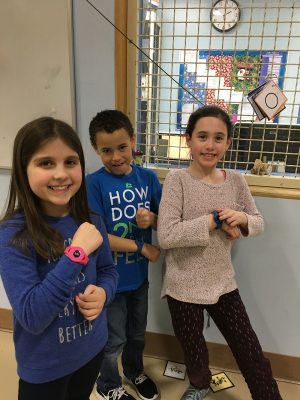
Bowman Elementary School third-graders Elle Baker, Turnel Hines and Caitlyn Ferman show their Sqord devices. (Photo courtesy Melanie Sutton, Anchorage School District)
One of his articles, published in Journal of Regional Science in 2014, studied the relationship between urban sprawl in U.S. metropolitan counties and the body mass index (BMI) of children living in those counties.
The rate of children becoming overweight or obese has tripled since 1980. One reason, according to the U.S. Centers for Disease Control, can be traced to how communities are designed and the number of recreational activities available. Children are less likely to get overweight or obese if they live in a place where they can safely walk, run, play, and have easy access to healthy foods.
Another of Guettabi's research projects, conducted for the Alaska Department of Health and Social Services, assessed the current and future medical costs of childhood obesity in Alaska, estimating the 20-year medical costs of obesity among the current cohort of Alaska children and teens would be $624 million in today's dollars.
'Kids are responding to it'
Sqords are not Fitbits; their faces do not display and track activity. The data they record about a child's movements-for example, while running, throwing a ball, dancing, riding a bike, swimming-are uploaded to a socially interactive website.
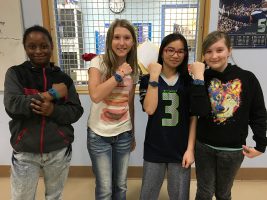
Bowman Elementary School students Kemontae Taylor, Sydney O'Brian, Melissa Tran and Kirsten Lockwood are fifth-graders who participated in a Sqord-based study conducted as part of an ISER, Providence, Healthy Futures, State of Alaska and Anchorage School District research collaboration. (Photo courtesy Melanie Sutton, Anchorage School District)
In Guettabi's study, only a certain group of students could access that website; the other students received a printout of their point totals every couple of weeks.
Preliminary findings from the study revealed: • Website access is positively associated with points earned. After controlling for demographics, students without access to the website earned 1,600 fewer points than they would have with access to the website. • Boys earned a little more than 3,000 points than girls, on average. • Students in Title 1 schools (schools with a high percentage of students from lower-income families) earned fewer points than those in non-Title 1 schools. • After accounting for demographics, access to the website does not seem to affect how long students choose to keep wearing the device.
"The kids that had better, complete access to the website earned more points," said Guettabi, who is now examining the extent to which incentives can help students reach their daily activity targets. "The social experience is positively associated with point accumulation. It seems kids are responding to it in a favorable way, which I think is an important finding."
In addition to the study schools, about 6,000 Sqords were activated and distributed to 36 schools in the fall of 2015. Another 16 schools-4,000 Sqords-were added last spring.
Some of the findings from the non-study schools included: • Students are least active on Sundays. • Students earn most of their points between 11 a.m. and 4 p.m. • The highest average number of hourly points were earned from 11 a.m. to noon. • The use of Sqords peaked in October 2015, with 4,473 devices active. • A lack of computer access didn't adversely affect physical activity.
The work still presents big hurdles, Jones said. Getting kids to keep up with the habit of consistently wearing the Sqords has been challenging. And too many kids still haven't reached the goal of accumulating the equivalent of an hour a day in points.
"It's a huge target," Jones said. "We're not there. The good thing is, now we have data to think through and do something with."
Written by Tracy Kalytiak, University of Alaska Anchorage
 "Motivating kids to move" is licensed under a Creative Commons Attribution-NonCommercial 4.0 International License.
"Motivating kids to move" is licensed under a Creative Commons Attribution-NonCommercial 4.0 International License.











